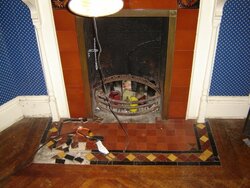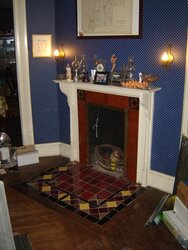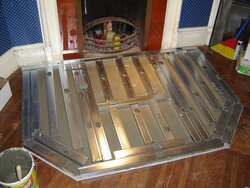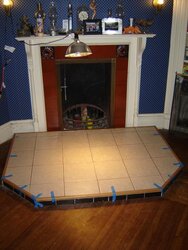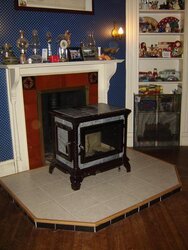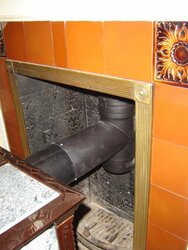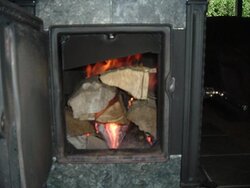Hi all - new to the group and just did our first burn on our new Heritage 8021. I plan to post the saga of the install (especially the hearth) but first I'm concerned about the amount of smoke this first burn experienced inside the stove. Our house is 123 years old and we had a 6" dia. stainless liner put into the chimney last year, w/ a damper at the top (cord w/ handle hangs @ left of fire box). The liner has to be at least 30 feet long (6 ft in room + 1 ft floor + 8 ft 2nd floor + 1 ft floor + 8 ft in attic + 6 feet outside = 30') and we knew it would never work for plain fires in our shallow firebox - just smoked the house up - so we'd have to add a draft inducer (fan @ top of flue) if we wanted it to ever be used in such a way. We still don't have a draft inducer now that the Heritage is installed. We also opted not to hook up a fresh air feed to the stove.
I attached some pix:
h1.jpg = the fireplace before we started this year - liner installed previous year.
h2.jpg = the first hearth I built (3 wks ago) and then discovered was woefully inadequate - shoulda read that book better! dangit
h3.jpg = steel beams set in mortar bed on Durock for new 68" x 48" x 3" raised hearth (built 2 wks ago)
h4.jpg = finished raised hearth - $19 (total!) of the best (cheapest!) tiles Home Despot sells.
h5.jpg = Heritage installed - yay!
h6.jpg = detail of the T-connection to the flue.
So there's the background, here's the concern: we did our first burn tonight and smoke just CHURNS inside this thing. It was a tiny burn, of course - nothing big, so we didn't get the pipes barely warmed up, so I understand that might be our biggest help (getting the flue fully heated up). While just burning the coals out, the firebox sat for a good hour filled with churning smoke. Opening the front door seemed to help a tiny bit in terms of clearing it out, but I'm really curious if people here feel my best bet is to go and hook up the fresh air intake - will it really make that much of a difference?
And has anyone ever seen cases of very tall chimneys like ours necessitating the installation of a draft inducing device?
Any help y'all can offer will be much appreciated - this is a great resource, very helpful while building my hearth!
-Ed
Stafford Springs, CT
I attached some pix:
h1.jpg = the fireplace before we started this year - liner installed previous year.
h2.jpg = the first hearth I built (3 wks ago) and then discovered was woefully inadequate - shoulda read that book better! dangit

h3.jpg = steel beams set in mortar bed on Durock for new 68" x 48" x 3" raised hearth (built 2 wks ago)
h4.jpg = finished raised hearth - $19 (total!) of the best (cheapest!) tiles Home Despot sells.
h5.jpg = Heritage installed - yay!
h6.jpg = detail of the T-connection to the flue.
So there's the background, here's the concern: we did our first burn tonight and smoke just CHURNS inside this thing. It was a tiny burn, of course - nothing big, so we didn't get the pipes barely warmed up, so I understand that might be our biggest help (getting the flue fully heated up). While just burning the coals out, the firebox sat for a good hour filled with churning smoke. Opening the front door seemed to help a tiny bit in terms of clearing it out, but I'm really curious if people here feel my best bet is to go and hook up the fresh air intake - will it really make that much of a difference?
And has anyone ever seen cases of very tall chimneys like ours necessitating the installation of a draft inducing device?
Any help y'all can offer will be much appreciated - this is a great resource, very helpful while building my hearth!
-Ed
Stafford Springs, CT


